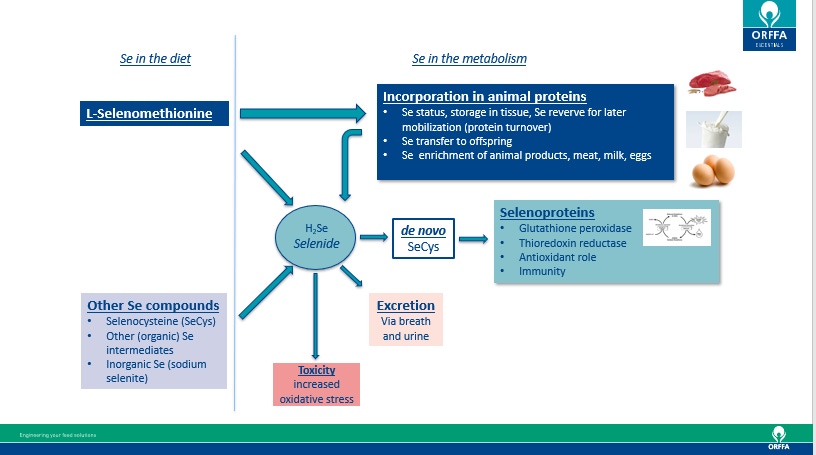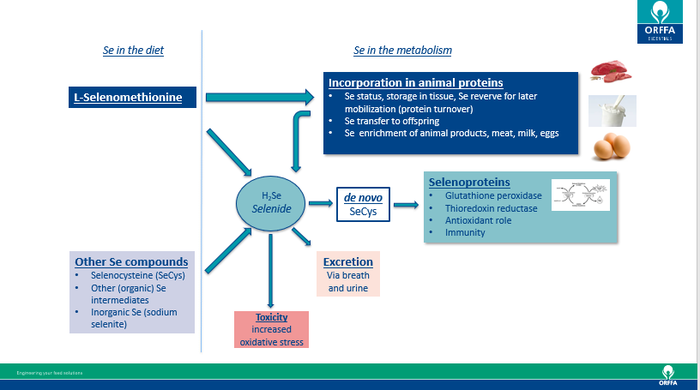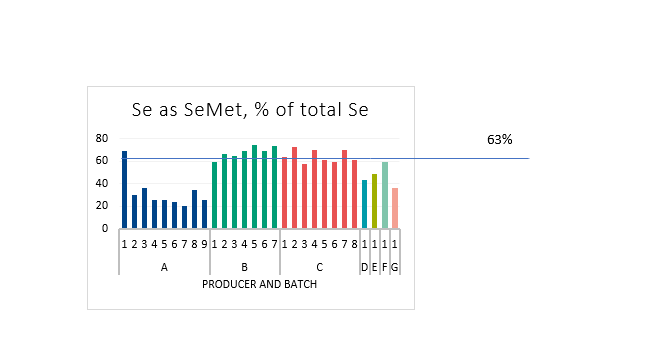June 7, 2019

Modern genetics have resulted in chicken characterised by high performance. The downside of this success is the high sensitivity to numerous stresses. To give the animal the chance to respond to these stresses in an sufficient way, selenium (Se) is added to the diet. As an essential trace element it is required for optimal performance, reproduction and immunity. Specific enzymes (selenoproteins) require the incorporation of Se to ensure their activity in the animal. These enzymes reduce the presence of reactive oxygen species (produced during normal metabolic activity and elevated during stressful periods) that cause cell damage and subsequent malfunctioning of tissues. Protection against these harmful byproducts is especially important in high energy demanding cells.
Selenium deficiency – a nutritional solution
Se can be added to the diet in either inorganic or organic forms. The advantage of using organic Se in the form of L-selenomethionine (SeMet) over inorganic sources (e.g. sodium selenite) is its ability to be incorporated directly into animal proteins. This incorporated Se (in the form of L-SeMet) acts as a storage depot of Se inside the animal (Figure 1). Other Se compounds are always reduced to hydrogen selenide (H2Se) and subsequently converted to de novo selenocysteine and incorporated into selenoproteins. Selenide does not function as a reserve of Se in the body and therefore any excess selenium is excreted to prevent toxicity occurring. L-SeMet is the only Se compound that can be directly, without conversion, built into animal structural proteins (i.e. muscle and liver). This ensures optimal Se supply, even during stressful periods (e.g. heat) when Se intake via the diet can be limited and at the same time in high demand to help reduce oxide radicals and spare cells from damage. Research has shown that Se from sodium selenite is excreted almost 3-fold more compared to Se from L-SeMet when fed to broilers confirming it as a non-storable form (Skrivan et al. 2008).
L-SeMet is generally supplied to the diet via addition of selenized yeast. Yeasts have the ability to incorporate Se in the form of L-SeMet, however this ability is limited. Normally, around 63% of the total Se in a selenised yeast is present as L-SeMet but there is a huge variation between products and batches (figure 2). L-SeMet incorporated in yeast protein is also not 100% bioavailable as it has to be first digested before it can be taken up by the animal. The remaining selenium absorbed by the yeast cells is present in forms which are no more active than much cheaper inorganic Se. From a health and safety perspective Excential Selenium 4000 (Orffa additives BV, The Netherlands) is supplied as a dust free preparation which provides all Se in the form of L-SeMet without variation in the concentration. Therefore, this product enables feed formulators to optimally supply animals with L-SeMet.
The effects of organic selenium in poultry
Stressful periods during life are plentiful and always correlated with an increased metabolic activity and energy demand that marks a period with high oxidative stress. To combat this stress the animal needs high amounts of Se. It is seen in literature that (heat) stressed chick embryos benefit from maternal Se in the form of L-SeMet compared to inorganic Se (Xiao et al. 2016). A significant increase in selenoprotein (e.g. glutathione peroxidase) production was seen and a reduction in reactive oxygen species (ROS) and malondialdehyde (biomarker for lipid peroxidation). L-SeMet is successful in improving the antioxidant defence of chick embryos as it is transferred efficiently and to a high extend from the diet to the egg. When comparing sodium selenite, selenized yeast and a dust free preparation of L-SeMet (Excential Selenium 4000) in their deposition of Se in the egg, the latter was able to increase the Se content in the egg to the highest extend (Delezie et al. 2014).
L-SeMet is not only able to sufficiently defend against (heat) stress in embryos, but also in broilers as it is also efficiently stored in muscle tissue as part of the proteins. When a chronic heat stress was supplied during the finisher period, broilers fed with L-SeMet had an improved BWG and reduced FCR (Michiels et al. 2016). After slaughter L-SeMet has also its positive effect on meat quality. Chick tissue is especially vulnerable to oxidative stress (lipid peroxidation) as it is rich in long chain polyunsaturated fatty acids (PUFA). L-SeMet not only reduces lipid peroxidation but also increases the alpha-tocopherol (vitamin E) content due to its recycling ability (Skrivan et al. 2008) and this to a higher extend then sodium selenite. Other trials show a reduction in drip loss of almost 1% after storage of the meat for 48 hours when diets are supplemented with L-SeMet compared to sodium selenite (Wang et al. 2011, Zhang et al. 2014).
Replacement of sodium selenite by organic selenium in broiler breeder diets has documented benefits on fertility, hatchability and viability of chicks during postnatal development. As L-SeMet is efficiently transferred from the diet to the egg and further to the developing embryo it helps the young chick to overcome hatching-related stresses. A long lasting maternal effect, up to slaughter, of L-SeMet could also be observed in some trials. Positive effects have also been observed by supplying laying hens with L-SeMet. Improved egg shell quality, production and freshness could be observed.
Lifted to maximum potential
Organic selenium (in the form of L-SeMet) has long-standing proven benefits over inorganic selenium, especially during stressful periods. Thanks to day-to-day engineering and innovation, organic selenium has been lifted to its maximum potential. Excential Selenium 4000 (Orffa Additives BV, the Netherlands) is the only organic product in the market providing all selenium in the most effective, bioavailable form (= L-Selenomethionine). There is no variation in concentration in comparison with other organic selenium sources (e.g. selenized yeasts) and on top of that it is the only organic Se source that ensures workers’ safety due to the absence of dust.
Figure 1 - The metabolism of L-Selenomethionine and other selenium compounds.

Figure 2: Commercial sample review selenized yeasts (n=28) from 7 producers (All About Feed, 16 Oct 2015)

Key Points to consider when using Excential Selenium 4000 (L-selenomethionine)
Multifunctional product –Used in selenoprotein enzymes synthesis and creates a storage pool of selenium in animal structural proteins (i.e. muscle and liver)
Stored selenium is released during times of stress and low feed intake
Consistent levels of selenium and L-selenomethionine for feed formulators
Dust free preparation of L-selenomethionine
Most other forms of selenium are less versatile and are prone to excretion. Poor return on investment.
Selenium transfer to meat and eggs (biofortification)
About the Author(s)
You May Also Like


.png?width=300&auto=webp&quality=80&disable=upscale)
